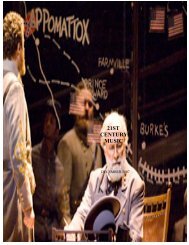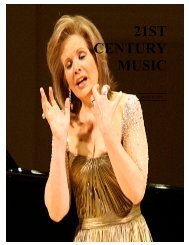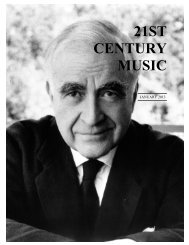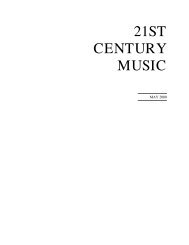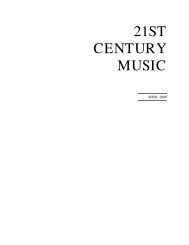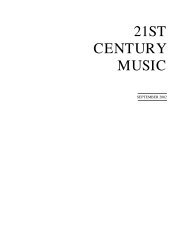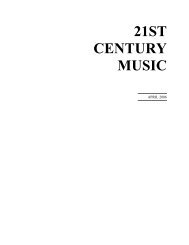Create successful ePaper yourself
Turn your PDF publications into a flip-book with our unique Google optimized e-Paper software.
The music on this release may certainly be construed to have<br />
its blemishes. An unsympathetic listener may find fault with<br />
DiDomenica's predilection for abrupt endings, granitic<br />
orchestration, slow unfolding, and blocky rhythms and<br />
gestures. But this critic must demur here. Clearly, this is not<br />
the work of an unskilled composer, but rather one who<br />
chooses to explore a personal means of expression. And in<br />
many ways, he succeeds; this is tough music to pigeonhole in<br />
terms of influence. The album opener Dream Journeys (1984),<br />
for example, sports a harmonic language that veers from<br />
Wagner (via quotes from Tristan and Isolde and the<br />
Wesendonk Lieder) to Berg and Ruggles, yet somehow does<br />
not sound like anyone else. Most interestingly, DiDomenica<br />
does this while evoking an atmosphere of low-key, musing<br />
austerity -- not the sort of feel one would automatically<br />
associate with any of this trio of earlier composers. Variations<br />
and Soliloquies (1988) exhibits a broader emotional palette.<br />
The two central soliloquy movements are spare and<br />
declamatory, effectively flanked by variation sets that belong<br />
to a more demonstrative, outgoing universe. And like the<br />
Wagner borrowings in Dream Journeys, this composition’s<br />
snitch of the waltz tune from Beethoven’s Diabelli Variations<br />
somehow sounds unique -- and right.<br />
The most immediately engaging selection on this release is his<br />
early Symphony (1961). This is obviously a young man’s<br />
endeavor, full of brash vigor and energy; one can sense<br />
DiDomenica’s glee at spinning this work out from the prototone-row<br />
found in the finale of Mozart’s Symphony no. 40.<br />
But even here, the piece’s craggy contours hint at this<br />
composer’s more iconoclastic mature work. And formal<br />
constructs in all cases are handled in clever and unusual ways.<br />
For example, the two themes from the Symphony’s opening<br />
sonata-form movement contrast strongly not only in melodic<br />
construction but also in tempo; the driving force of this<br />
movement consists not so much of the harmonic progression<br />
of these themes, but rather their gradual exchange of tempi.<br />
It’s a fascinating take on this old format.<br />
Sound quality and production are fine. Performances, by the<br />
Radio Philharmonic of Hanover conducted by Gunther<br />
Schuller, are excellent -- very strong and sympathetic. This<br />
disc is an unusual, but worthy listen.<br />
Ms. Green's Keen<br />
MARK ALBURGER<br />
Nancy Green. Tovey and Kodaly: Two Sonatas for Solo Cello<br />
[Donald Francis Tovey. Sonata in D for Solo Cello, op 30<br />
(1913). Zoltán Kodály. Sonata for Solo Cello, op. 8 (1915).<br />
Nancy Green, Cello. JRI Recordings.<br />
Nancy Green and Frederick Moyer. Schumann, Mendelssohn,<br />
Debussy, Britten [Claude Debussy. Sonata for Cello and<br />
Piano (1915). Benjamin Britten. Sonata in C, op. 65 (1961)].<br />
Nancy Green, cello; Frederick Moyer, piano. JRI Recordings.<br />
A theme of cellist Nancy Green's two fine JRI Recordings<br />
could almost be the second decade of the 20th century,<br />
discounting Benjamin Britten's work, which, if inverted could<br />
read 1916 instead of 1961. Nevertheless, Green, aptly paired<br />
with pianist Frederick Moyer in two of the tour selections<br />
discussed here, offers three intriguing works that date within<br />
roughly a span of three years in relation one another.<br />
But what contrasts! Donald Francis Tovey's Sonata in D for<br />
Solo Cello, op. 3, could hardly be different from Zoltán<br />
Kodály's Sonata for Solo Cello, op. 8 (1915) and still be for<br />
the same unaccompanied instrument. Tovey takes his cues<br />
from Bach and Brahms, and though these inspirations are<br />
admirably updated, maintains his reputation as primarily a<br />
writer on music, rather than an composer of first rank. His<br />
three-movement sonata is replete with virtuosity, all carried<br />
off in a first-rate fashion by Green, but it remains more an<br />
interesting homage, right through the finale "Passacaglia" than<br />
an arresting burst of creativity. The same cannot be said of the<br />
Kodály.<br />
Unquestionably, the virtuosity is still here, but the passion and<br />
earthiness are completely unlike the previous. Green captures<br />
the excitement of the music. And while Kodály is no less than<br />
Tovey inspired by previous models -- in this case, of course,<br />
Hungarian folk music -- the results are strikingly original and<br />
engaging.<br />
Claude Debussy's Sonata for Cello and Piano, dating from the<br />
exact year of the Kodály, is again in marked contrast. Again<br />
there is virtuosity, but instead of Hungarian folkishness we<br />
have French refinement. Instead of Tovey's baroque and<br />
romantic allusions, we find Debussy's antique and<br />
contemporary enthusiasms. A certain austerity and anger mix<br />
into the beauty in this musical response to German political<br />
aggression. Debussy called it "Pierrot angry at the moon" --<br />
Pierrot Colère Lunaire Benjamin Britten, here with touches<br />
of Bartók and Shostakovich fits smoothly into this repertory.<br />
One has always suspected that, aside from a few obligatory<br />
modern touches, this composer would have been as happy<br />
writing in 1916 and 61 anyway. The English composer crafts<br />
his impressively striking and rhapsodic Sonata in C in five<br />
movements, and Green carries off her role as expertly as the<br />
music's dedicatee, Mstislav Rostropovich. Moyer is similarly<br />
up to the challenges throughout.<br />
31



